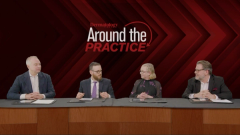
Patient Case #1: AD Treatment Approaches
Elizabeth Swanson, MD, and Brad Glick, DO, MPH, FAOCD, share treatment approaches for pediatric patients with AD.
Episodes in this series

Jonathan I Silverberg, MD, PhD, MPH: Let’s drill down a bit more. In a case like this, where do you start from a topical management perspective, what’s that starting point for both of you? Then we’ll shift and we’ll come full circle, so then how do we decide systemic therapy?
Elizabeth Swanson, MD: In a patient like this, 6 years old, I would probably grade it as moderate atopic dermatitis. I would present options like a classic option consisting of a topical steroid for flares and a nonsteroid for maintenance in some way. I would probably also talk about a compounded product we use a lot in pediatric dermatology called the Aron Regimen. I don’t know if you guys have dabbled much in that, but it’s a compounded mix of betamethasone valerate and mupirocin. It’s all in a 1-lb tub with either a Vanicream or a Plastibase base. You can use it up to 5 times a day for flare-ups, and you can use it once at bedtime for prevention and maintenance. I use a lot of that. It’s appealing to families who are even a little fearful of topical steroids because it’s so incredibly dilute. For this patient, I would describe a conventional regimen with a topical steroid and a nonsteroid. I would describe the Aron Regimen, and then I would tell them about dupilumab. He’s very much in that age range. Especially with the impact the itch is having, I think it’s worth considering. I commonly tell my patients and their families that itch and happiness are inversely related. As your itch increases, your happiness decreases, but the converse is true. As your itch decreases, your happiness increases and you have a lot of very happy people.
Brad Glick, DO, MPH, FAOCD: Cycling therapy is what I like to call it, and I explain that to my patients. I give them a little burst of corticosteroids. It could be something as potent as betamethasone valerate or as reasonably mild to moderate as mometasone furoate for a couple of weeks, and then I’ll cycle in one of the topical calcineurin inhibitors. Obviously, we have 2 of them. And dare I say this because we’ve had some reasonable success with it, but we do have a topical PDE4 inhibitor in crisaborole, it’s approved down to the age of 3 months. You have to make sure I get that right, Dr Swanson. I do find for a lot of the patients, even a 6-year-old and the parents, it’s been a tough sell at times too, because of the burning and stinging, and you have to chase after that. That’s how I’d handle that. I’d also just make sure what emollient they’re using. Is it a ceramide-containing emollient, a…degradation product type of emollient? There are a lot of very effective emollients out there. As I usually say, I’m a moisturizer freak. It’s really important to me to make sure there’s barrier restoration, and that’s where I start. I agree with Dr Swanson, the fact that we have an injectable therapy, tough sell as it may be to parents, that goes down now to the age of 6 months, I think is a reasonable conversation in the modern era of taking care of children with atopic dermatitis.
Elizabeth Swanson, MD: It will also be nice when we have additional topical nonsteroids available in this particular patient population. It’ll be nice when topical ruxolitinib gets approved for patients younger than 12. It’s a wonderful medication that’s so effective, and offers a lot of the speed and overall improvement of a topical steroid without being a steroid. I can’t wait for the age indication to be younger. Then we know that topical roflumilast and tapinarof, which are approved in the psoriasis community, are coming for the atopic dermatitis community. I’m excited to utilize those. I think those are going to be really appealing to patients and their parents.
Jonathan I Silverberg, MD, PhD, MPH: I agree.
Elizabeth Swanson, MD: Hopefully our topical option list will be growing in this particular subset of patients down the road, but that’s the thing I would present right now.
Jonathan I Silverberg, MD, PhD, MPH: I hope I can access some of those newer nonsteroidal options without having to go through steroids first. The insurance companies will have their own say in this, but most parents, after they go on social media, are scared of topical steroids. We would all agree, it’s probably overblown most of the time, but you don’t want to waste 20 minutes in the clinic talking them down. And they’re never fully confident in the therapy, which means they’re not going to give it a fair shake. I’d rather give them something, and like topical crisaborole, even if efficacy-wise it might be less effective than betamethasone, they actually use it because they’re not scared of it. And sometimes they’ll get better results because they’re putting it on.
Transcript edited for clarity
Newsletter
Like what you’re reading? Subscribe to Dermatology Times for weekly updates on therapies, innovations, and real-world practice tips.






















